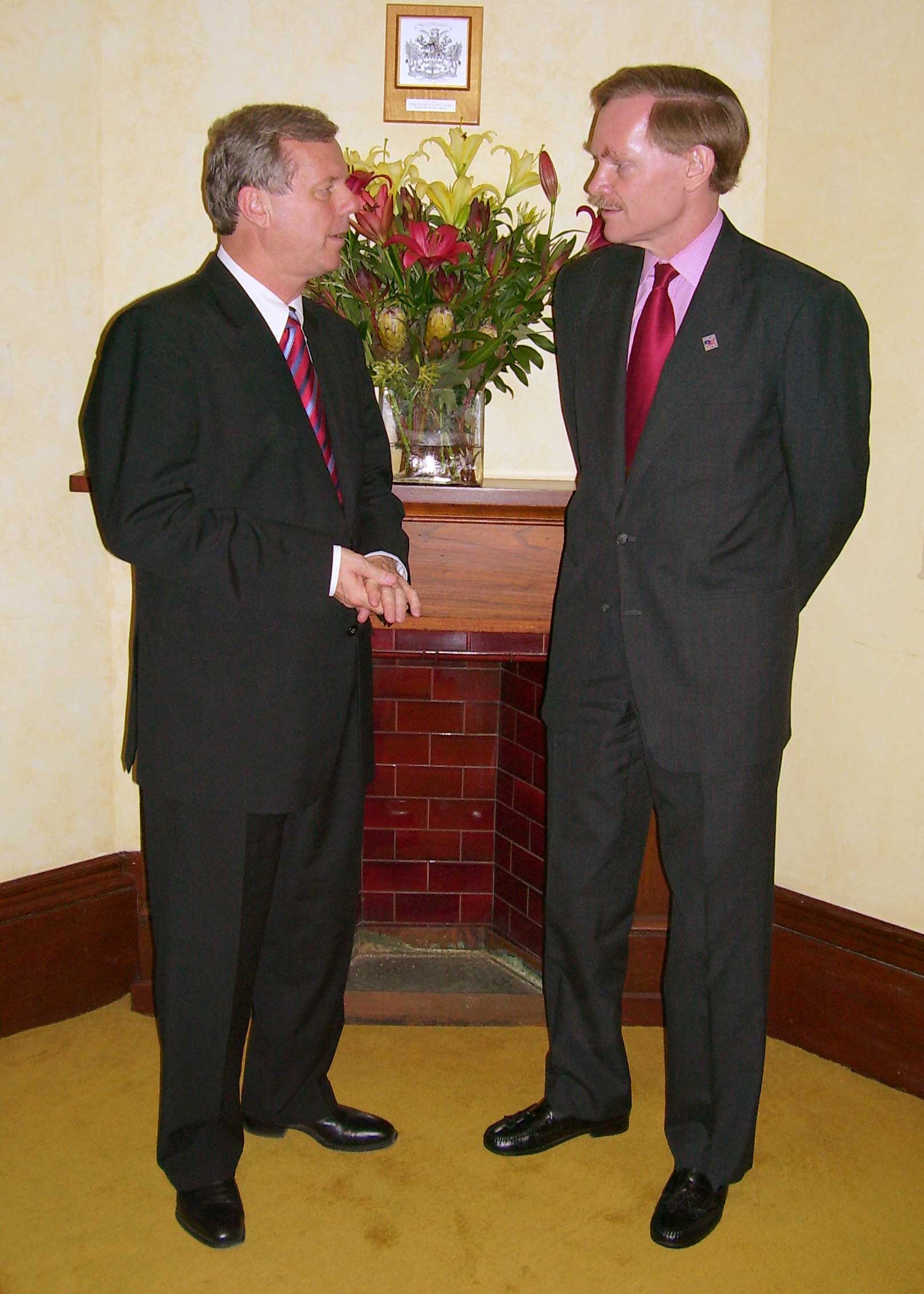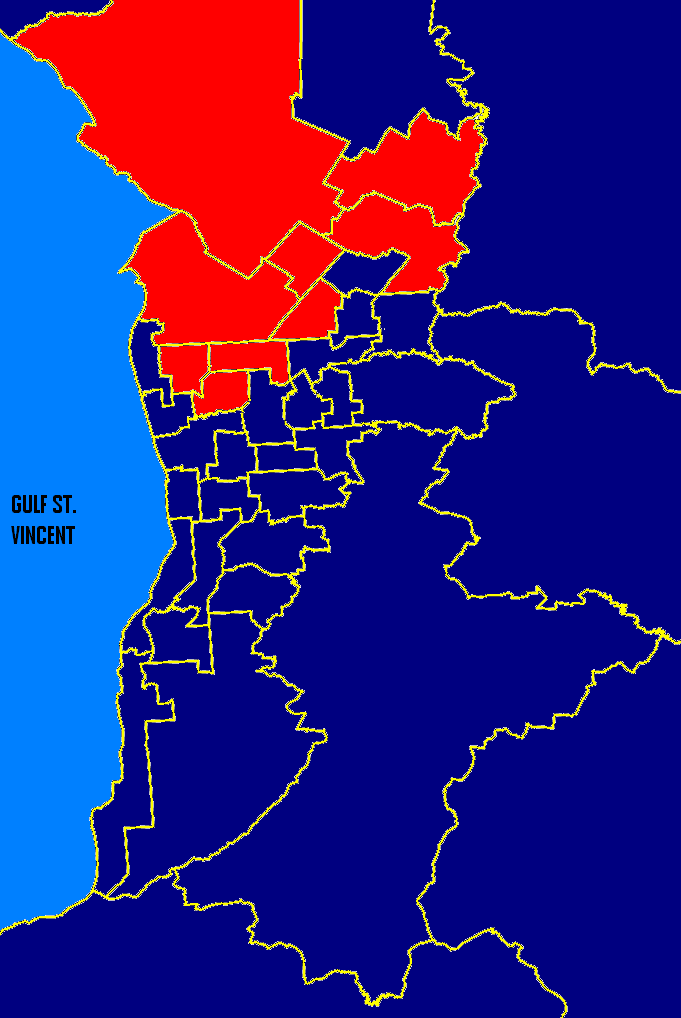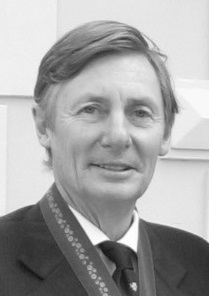|
John Quirke
John Andrew Quirke (born 9 September 1950) is a former Australian politician. He served as a Senator for South Australia from 1997 to 2000, representing the Australian Labor Party (ALP). He previously served in the South Australian House of Assembly from 1989 to 1997, holding the seat of Playford. Early life Quirke was born in Birkenhead, Cheshire, England, the son of Mary () and William Patrick Quirke. His father was a fitter at a shipbuilding company on the Mersey. The family immigrated to Australia as Ten Pound Poms in 1959. They settled in Adelaide, South Australia, where Quirke attended Elizabeth High School. He subsequently graduated from the University of Adelaide with a Bachelor of Arts and a Diploma of Education. From 1973 to 1977 Quirke was a history teacher at Craigmore High School. He then transferred to Concordia College, a Lutheran school. Politics Early involvement Quirke joined the ALP in 1979 and served as president of its Mount Lofty branch. He was elected ... [...More Info...] [...Related Items...] OR: [Wikipedia] [Google] [Baidu] |
Australian Senate
The Senate is the upper house of the Bicameralism, bicameral Parliament of Australia, the lower house being the House of Representatives (Australia), House of Representatives. The composition and powers of the Senate are established in Chapter I of the Constitution of Australia. There are a total of 76 senators: 12 are elected from each of the six states and territories of Australia, Australian states regardless of population and 2 from each of the two autonomous internal states and territories of Australia, Australian territories (the Australian Capital Territory and the Northern Territory). Senators are popularly elected under the single transferable vote system of proportional representation. Unlike upper houses in other Westminster system, Westminster-style parliamentary systems, the Senate is vested with significant powers, including the capacity to reject all bills, including budget and appropriation bills, initiated by the government in the House of Representatives, maki ... [...More Info...] [...Related Items...] OR: [Wikipedia] [Google] [Baidu] |
Concordia College (South Australia)
Concordia College (CC) is an ELC-12 independent, co-educational, Lutheran school with campuses located in the Highgate and Blackwood areas of Adelaide, South Australia. Established in 1890, the college is a school of the Lutheran Church of Australia and has been an International Baccalaureate (IB) World School since January 2001, offering the IB Primary Years and Middle Years Programmes. History Concordia College was founded by W. F. Peters, a Lutheran pastor in the Victorian country township of Murtoa. Peters purchased a private school founded in 1887 by T. W. Boehm, and re-established it in 1890 as a boys' college and training ground for future pastors and teachers. Lutheran leaders in South Australia moved the college to its present Highgate site in 1905. With the involvement of Pastor P. B. Zweck, Concordia became a Christian co-educational secondary college in 1927, operating under the South Australian District Synod of the Lutheran Church of Australia. Today, th ... [...More Info...] [...Related Items...] OR: [Wikipedia] [Google] [Baidu] |
Mike Rann
Michael David Rann, , (born 5 January 1953) is an Australian former politician who was the 44th premier of South Australia from 2002 to 2011. He was later Australian High Commissioner to the United Kingdom from 2013 to 2014, and Australian ambassador to Italy, Albania, Libya and San Marino from 2014 to 2016. Rann grew up in the United Kingdom and New Zealand, completing a Bachelor and Master of Arts in political science at the University of Auckland. Before entering Parliament, Rann worked as an advisor to South Australian Labor Parliamentarians. Rann became leader of the South Australian Branch of the Australian Labor Party and South Australian Leader of the Opposition in 1994 and led the party to minority government at the 2002 election. He resigned as Premier in October 2011 and was succeeded by Jay Weatherill. Rann is the third- longest serving Premier of South Australia behind Thomas Playford IV and John Bannon and served a record 17 years as South Australian Labor pa ... [...More Info...] [...Related Items...] OR: [Wikipedia] [Google] [Baidu] |
1993 South Australian State Election
State elections were held in South Australia on 11 December 1993. All 47 seats in the South Australian House of Assembly were up for election. The incumbent Australian Labor Party led by Premier of South Australia Lynn Arnold was defeated by the Liberal Party of Australia led by Leader of the Opposition Dean Brown. The Liberals won what is still the largest majority government in South Australian history. Background The campaign was dominated by the issue of the collapse of the State Bank of South Australia in 1991. The State Bank's deposits were legally underwritten by the Government of South Australia, putting South Australia into billions of dollars of debt. Labor premier John Bannon had resigned over the issue in 1992, being replaced by Lynn Arnold just over a year before the election. The Liberals also changed leaders in 1992, switching from Dale Baker to Dean Brown. Following the Labor leadership change and by early 1993, Newspoll had recorded a total rise of 13 percent in ... [...More Info...] [...Related Items...] OR: [Wikipedia] [Google] [Baidu] |
Multifunction Polis
The Multifunction Polis (MFP) was a controversial scheme for a planned community in Australia proposed in 1987 and abandoned in 1998. From the Greek word "polis", meaning "city", it was imagined as a place where work and leisure, lifetime education and intercultural exchange, research and manufacturing would be uniquely integrated. The MFP was intended to have an initial population of 100,000, though some modelling was done on the assumption of a population up to 250,000. Futuristic infrastructure and modern communications were expected to help attract high-tech industries. Asian investors were targeted as an important source of funds, with an emphasis on Japanese investors. [...More Info...] [...Related Items...] OR: [Wikipedia] [Google] [Baidu] |
Backbencher
In Westminster and other parliamentary systems, a backbencher is a member of parliament (MP) or a legislator who occupies no governmental office and is not a frontbench spokesperson in the Opposition, being instead simply a member of the "rank and file". The term dates from 1855. The term derives from the fact that they sit physically behind the frontbench in the House of Commons. A backbencher may be a new parliamentary member yet to receive high office, a senior figure dropped from government, someone who for whatever reason is not chosen to sit in the government or an opposition spokesperson (such as a shadow cabinet if one exists), or someone who prefers to be a background influence, not in the spotlight. By extension, those who are not reliable supporters of all of their party's goals and policies and have resigned or been forced to resign may be relegated to the back benches. For example, in British political events, Clive Lewis became a backbencher after resigning ... [...More Info...] [...Related Items...] OR: [Wikipedia] [Google] [Baidu] |
1989 South Australian State Election
State elections were held in South Australia on 25 November 1989. All 47 seats in the South Australian House of Assembly were up for election. The incumbent Australian Labor Party led by Premier of South Australia John Bannon defeated the Liberal Party of Australia led by Leader of the Opposition John Olsen. Labor won 22 out of 47 seats, and secured a majority of 24 with the support of two Independent Labor members. Background Parliamentary elections for both houses of the Parliament of South Australia were held in South Australia in 1989. John Bannon's Labor government had initially presided over an economic boom, but at the time of the election the economy had slowed due to the late 1980s recession. The Liberals' campaign accused Bannon of inaction during the poor economic conditions, capitalising on the fact that he was national president of Australian Labor Party at the time. Outcome The Liberals gained five seats (Adelaide, Bright, Fisher, Hayward and Newland), but Labor ... [...More Info...] [...Related Items...] OR: [Wikipedia] [Google] [Baidu] |
1985 South Australian State Election
State elections were held in South Australia on 7 December 1985. All 47 seats in the South Australian House of Assembly were up for election. The incumbent Australian Labor Party led by Premier of South Australia John Bannon increased its majority, and defeated the Liberal Party of Australia led by Leader of the Opposition John Olsen. Background Parliamentary elections for both houses of the Parliament of South Australia were held in South Australia on 7 December 1985, which saw John Bannon and the Australian Labor Party win a second successive term, against the Liberal Party of Australia opposition led by John Olsen. Labor won the election with an increased majority–at the time, the biggest majority it had held since the end of the Playmander, a record that would stand until 2006. The Liberal Party retained John Olsen as leader, partly because his main rival Dean Brown lost his seat to Independent Liberal Stan Evans. Evans rejoined the Liberal Party soon after the election. ... [...More Info...] [...Related Items...] OR: [Wikipedia] [Google] [Baidu] |
Electoral District Of Alexandra
Alexandra was an electoral district of the House of Assembly in the Australian state of South Australia from 1902 to 1992, and was formed when the electoral districts of Encounter Bay, Mount Barker and Noarlunga were amalgamated. The district included the Fleurieu Peninsula, to the south of Adelaide. Alexandra was renamed Finniss at the 1993 state election. Members for Alexandra See also * 1992 Alexandra state by-election A by-election was held for the South Australian House of Assembly seat of Alexandra on 9 May 1992. This was triggered by the resignation of former state Liberal MHA Ted Chapman. The seat had been retained by the Liberals since it was created and f ... References External links1985 & 1989 election boundaries, page 18 & 19 [...More Info...] [...Related Items...] OR: [Wikipedia] [Google] [Baidu] |
Division Of Mayo
The Division of Mayo is an Australian electoral division located to the east and south of Adelaide, South Australia. Created in the state redistribution of 3 September 1984, the division is named after Helen Mayo, a social activist and the first woman elected to an Australian University Council. The 9,315 km² rural seat covers an area from the Barossa Valley in the north to Cape Jervis in the south. Taking in the Adelaide Hills, Fleurieu Peninsula and Kangaroo Island regions, its largest population centre is Mount Barker. Its other population centres are Aldgate, Bridgewater, Littlehampton, McLaren Vale, Nairne, Stirling, Strathalbyn and Victor Harbor, and its smaller localities include American River, Ashbourne, Balhannah, Brukunga, Carrickalinga, Charleston, Cherry Gardens, Clarendon, Crafers, Cudlee Creek, Currency Creek, Delamere, Echunga, Forreston, Goolwa, Gumeracha, Hahndorf, Houghton, Inglewood, Kersbrook, Kingscote, Langhorne Creek, Lobethal, M ... [...More Info...] [...Related Items...] OR: [Wikipedia] [Google] [Baidu] |
Alexander Downer
Alexander John Gosse Downer (born 9 September 1951) is an Australian former politician and diplomat who was leader of the Liberal Party from 1994 to 1995, Minister for Foreign Affairs from 1996 to 2007, and High Commissioner to the United Kingdom from 2014 to 2018. Downer was born in Adelaide, the son of Sir Alick Downer and the grandson of Sir John Downer. After periods working for the Bank of New South Wales and with the diplomatic service, he was appointed executive director of the Australian Chamber of Commerce in 1983. He also served as an advisor to Liberal leaders Malcolm Fraser and Andrew Peacock. Downer was elected to parliament at the 1984 federal election, winning the Division of Mayo in South Australia. He was added to the opposition frontbench in 1987. After the Coalition lost the 1993 election, John Hewson's position as leader of the Liberal Party came into question. Downer successfully challenged him for the leadership in May 1994, thus becoming Leader of ... [...More Info...] [...Related Items...] OR: [Wikipedia] [Google] [Baidu] |
1984 Australian Federal Election
The 1984 Australian federal election was held in Australia on 1 December 1984. All 148 seats in the House of Representatives (24 of them newly created) and 46 of 76 seats in the Senate (12 of them newly created) were up for election. The incumbent Labor Party led by Prime Minister Bob Hawke defeated the opposition Liberal–National coalition, led by Andrew Peacock. The election was held in conjunction with two referendum questions, neither of which was carried. Background and issues The election had a long campaign and a high rate of informal voting for the House of Representatives, but decreased rate in the Senate (due to the introduction of the Group voting ticket). The election was held 18 months ahead of time, partly to bring the elections for the House of Representatives and Senate back into line following the double dissolution election of 1983. The legislated increase in the size of the House of Representatives by 24 seats and the Senate by 12 seats came into eff ... [...More Info...] [...Related Items...] OR: [Wikipedia] [Google] [Baidu] |




_2007.jpg)

.jpg)


